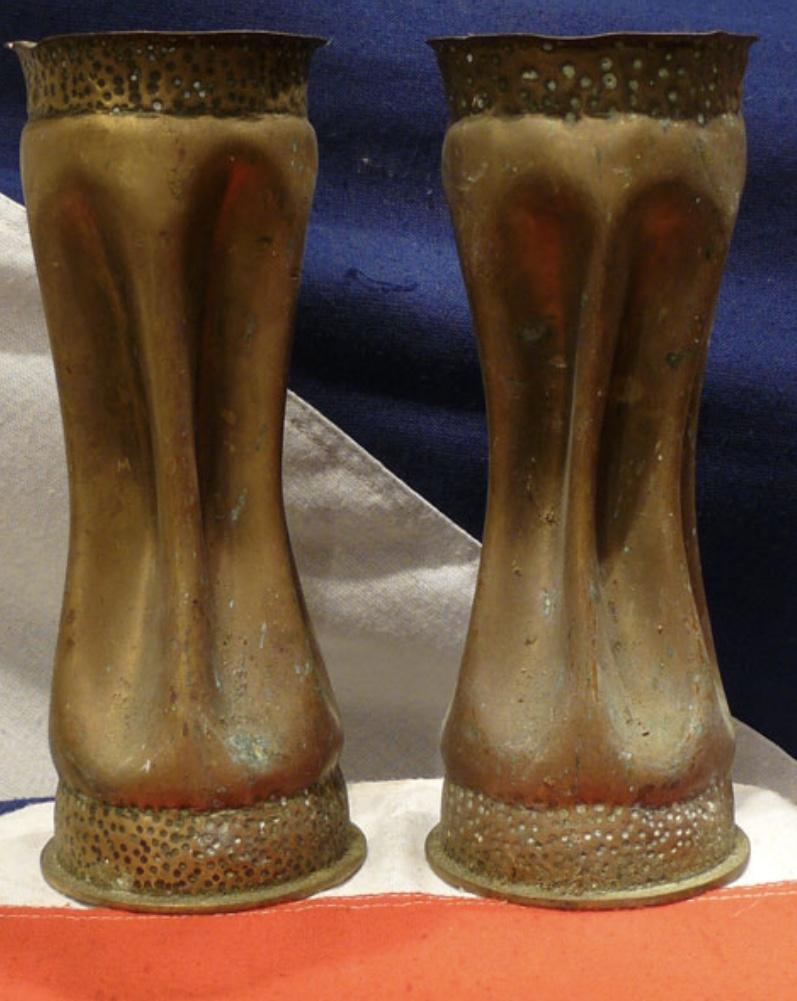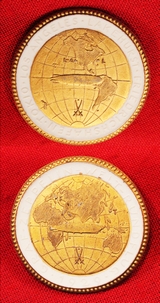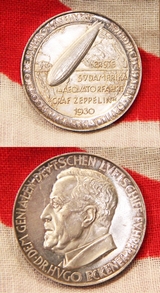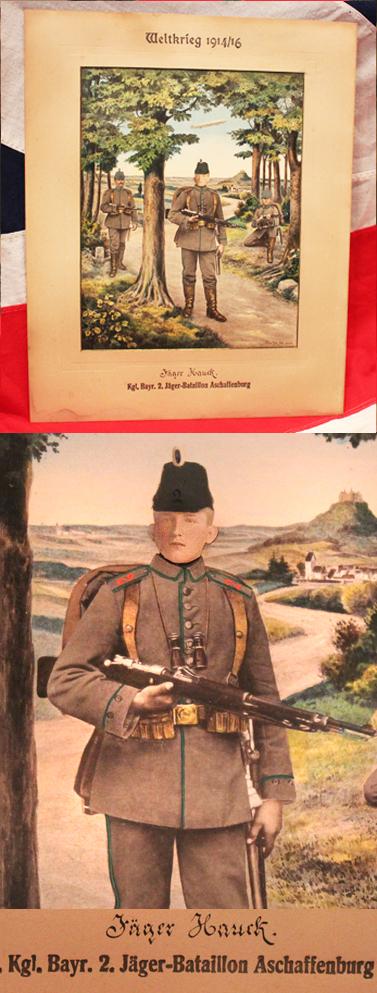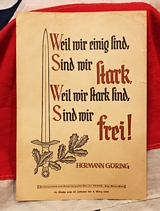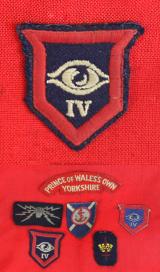WW1 / WW2 / 20th Century
An Iconic Example of Now Highly Collectable Military Artwork of WW1. German Artillery Shell Trench Art Vases Dated August 1917
In need of tender hand polishing that would reveal superb results. 9 inches high
Trench art objects are holders of soldiers’ memories and reminders of the conflict they faced. Made out of recycled war refuse such as shell casings, spent bullets or whatever came to hand, they open a window to the past. They tell us things like where soldiers went and what their surroundings were like. They also give hints about soldiers’ thoughts and actions. Something as simple and functional as a matchbox cover can provide a map of a soldier’s movements while other, more decorative examples, show a desire to find and create beauty, to camouflage war in art
Trench art can be made of any number of things. Many objects were made out of the scraps created by war. This included ammunition shell cases, bullet casings, shrapnel, and pieces of destroyed buildings or downed planes. These materials would all have been readily available in the war zones to soldiers, their prisoners of war and to civilians still in the area. Some objects appear to have little to do with the war full stop. Turkish prisoners of war started a bustling business in objects made of glass beads which commemorated the war. read more
140.00 GBP
A Very Fine Quality Meissen Porcelain Round the World Medal
A rare and most desireable medal a most fine collectors piece 1929 Graf Zeppelin World Flight Medal. White bisque porcelain, and gilt 48mm.
Obv. Airship over Eastern
Hemisphere globe, GRAF ZEPPELIN WELT
RUNDFLUG . Rev. Airship over Western Hemisphere globe, FRIEDRICHSHAFEN. TOKIO. LOS ANGELES. LAKEHURST . A classic Zeppelin
issue made by the State Porcelain Factory of Meissen, mintmark crossed swords. The tour began in Friedrichshafen, Germany, where the Graf Zeppelin was built, and continued on to Tokyo, Los Angeles, and Lakehurst, NJ (where her sister ship, the Hindenburg, exploded in May 1937) before returning to Germany. read more
265.00 GBP
Rare German Zeppelin Aerospace Medal 1930 1st South America Brazil flight
German Aerospace medal. Silver Medal 1930 (O. Gl?ckler) First South American cruise of "LZ 127". Head of Dr. H. Eckener left / airship across the Atlantic between Europe and South America. Edge hallmark: PREUSS.STAATSMiNZE.SILBER 900 FINE. 36.2 mm, 24.8 g, small edge error, excellent overall.
LZ 127 Graf Zeppelin (Deutsches Luftschiff Zeppelin 127) was a German passenger-carrying, hydrogen-filled rigid airship that flew from 1928 to 1937. It offered the first commercial transatlantic passenger flight service. Named after the German airship pioneer Ferdinand von Zeppelin, a count (Graf) in the German nobility, it was conceived and operated by Dr. Hugo Eckener, the chairman of Luftschiffbau Zeppelin.
Graf Zeppelin made 590 flights totalling almost 1.7 million kilometres (over 1 million miles). It was operated by a crew of 36, and could carry 24 passengers. It was the longest and largest airship in the world when it was built. It made the first circumnavigation of the world by airship, and the first nonstop crossing of the Pacific Ocean by air; its range was enhanced by its use of Blau gas as a fuel. It was built using funds raised by public subscription and from the German government, and its operating costs were offset by the sale of special postage stamps to collectors, the support of the newspaper magnate William Randolph Hearst, and cargo and passenger receipts.
After several long flights between 1928 and 1932, including one to the Arctic, Graf Zeppelin provided a commercial passenger and mail service between Germany and Brazil for five years. When the Nazi Party came to power, they used it as a propaganda tool. It was withdrawn from service after the Hindenburg disaster in 1937, and scrapped for military aircraft production in 1940. read more
260.00 GBP
An Intriguing Zeppelin Warfare Interest Original Bespoke Portrait Photo and Coloured Print of an Imperial German Rifleman in WW1 From The Photographic Wolf Studio of Ulm
A personal portrait photo of a German WW1 rifleman that has been onlaid onto the patented print, of three infantrymen, and him centre from his regiment, the 2nd Jager Battalion Aschaffenberg, Jager [rifleman] Hauck of the Bavarian Infantry in a wooded scene, and his name inscribed below. They were unique patented items that were created for the family members of the soldier for posterity. Photographic studio, A.Wolf of Ulm. 420mm x 525mm. Mounted and unframed. Would look stunning nicely reframed . One of two stunning and rare matching examples of original Great War period Imperial German Zeppelin and infantry warfare prints we acquired that we are selling separately read more
325.00 GBP
An Original Imperial German WW1 Zeppelin Warfare Interest, Bespoke. And Coloured Print of a German Infantryman, Landsturmann Lantz. From the Wolf Photographic Studio of Ulm.
Landwehr Infantry Regt. Nr.123 Ravensburg A personal portrait photo of a German WW1 rifleman that has been onlaid onto the patented print, of three infantrymen, and the subject from his regiment. Imperial German Infantrymen in a wooded scene, with a Zeppelin in the background and his name inscribed below. They were unique patented German photographic records of WW1 that were created for the family members of the soldier for posterity by a photographic studio and print shop. A Wolf of Ulm. 330mm x 450mm. Sold un-mounted and unframed. It would look absolutely stunning nicely reframed. One of two stunning and rare matching examples of original Great War period Imperial German Zeppelin and infantry warfare prints we acquired that we are selling separately. read more
325.00 GBP
WW1 Imperial German Officer's sword 73rd Reserve Regiment. Company 16 Sword 1
A gilt brass-bronze hilt with silver wire bound grip and folding shell guard, maker marked blade by Wayersberg Kirschbaum, Solingen. Regimentally marked with the Kiaser’s ordnance inspection stamp. The 19th Reserve Division, 37th Reserve Brigade, 73rd reserve infantry regiment, began the war under command of Generalleutnant Max von Bahrfeldt on the Western Front, participating in the opening German offensive which led to the Allied Great Retreat and ended with the First Battle of the Marne. Thereafter, the division remained in the line on the Aisne and in the Champagne. From May 1915 to March 1916, the division fought in Upper Alsace. It then fought in the Battle of Verdun until July, when it went into the Argonne Forest. In October 1916, it saw action in the later phases of the Battle of the Somme. In April 1917, the division fought in the Second Battle of the Aisne, also known as the Third Battle of Champagne. In May, it was sent to the Eastern Front, and fought around Riga until September. It then returned to the Western Front, where it saw action in the Battle of Passchendaele. It was back in the trenchlines at Verdun from October 1917 to April 1918. In August–September 1918, the division faced the French and American Oise-Aisne Offensive. It remained in the line until war's end. Allied intelligence rated the division as first class. No scabbard read more
395.00 GBP
A Fascinating Most Rare Original Election Propaganda Poster of a Post WW1 German Political Party That Was Absorbed Into The Nazi NSDAP German National People’s Party. Designed by Richard Müller, Chemnitz.
A Reichstag election poster of the German National People's Party.
Wohin die fahrt?
nach nationaler einheit u freiheit
wahlt deutschnational
Where are you going?
according to national unity and freedom
elect a German national
The German National People's Party (German: Deutschnationale Volkspartei, DNVP) was a national-conservative party in Germany during the Weimar Republic. Before the rise of the Nazi Party, it was the major conservative and nationalist party in Weimar Germany. It was an alliance of nationalists, reactionary monarchists, völkisch and antisemitic elements supported by the Pan-German League After 1929, the DNVP co-operated with the socialist Nazis, joining forces in the Harzburg Front of 1931, forming coalition governments in some states and finally supporting Hitler's appointment as Chancellor (Reichskanzler) in January 1933. Initially, the DNVP had a number of ministers in Hitler's government, several prominent Nazis began their careers in the DNVP., but the party quickly lost influence and eventually dissolved itself in June 1933, giving way to the Nazis' single-party dictatorship, the majority of its former members joining the Nazi party. The Nazis allowed the remaining former DNVP members in the Reichstag, the civil service, and the police to continue with their jobs and left the rest of the party membership generally in peace
During the Second World War, several prominent former DNVP members, such as Carl Friedrich Goerdeler, were involved in the German resistance against the Nazis and took part in the 20 July assassination plot against Hitler in 1944. Approx size A4. read more
220.00 GBP
Reich Marshall Herman Goering Small Propaganda Poster With Luftwaffe Sword
In very good condition for age. Rarely surviving piece from the the pre war Germany.Weil wir einig sind, sind wir stark, weil wir stark sind, sind wir frei. ... Hermann Goring", " Because We Are United We Are Strong, Because We Are Strong We Are Free" 28th of February to 6th Martch 1938. [weekly slogans of the National Socialist German Workers' Party]. Another original copy of it is in the George C Marshall Foundation library During World War II, Marshall as Army Chief of Staff (1939-1945) was the most important military figure in the U.S. military establishment and of great significance in maintaining the Anglo-American coalition. After the war, he was named special ambassador to China (1945-1947), Secretary of State (1947-1949), President of the American Red Cross (1949-1950), and Secretary of Defense (1950-1951). In 1953 he was awarded the Nobel Peace Prize for his role in proposing, encouraging legislative action, and supporting the European Recovery Program (known as the Marshall Plan). For nearly 20 years he was a major U.S. leader, militarily, politically and morally, and he is still widely admired today. read more
245.00 GBP
Original Uniform Removed British Formation Badges 1939-1945 & King George VIth
An embroidered cloth shoulder title for the Prince of Wales's Own Regiment of Yorkshire, comprising a base of scarlet wool cut in an arc and embroidered on obverse with the title of the regiment "PRINCE OF WALES'S OWN YORKSHIRE" in white thread, and 5 formation badges, including the 4th Guards Armoured. Formation signs were first used by the British Army in WW1 in order to provide an easy method of visual identification of the various units. They were worn on the upper sleeve in pairs, on epaulets, on head gear, painted on unit vehicles, and used on road signs. It was also quickly found that the signs created a morale boosting esprit de corps as each unit became proud of its own symbol. After WW1 the use of formation signs was discontinued, they were reintroduced at the outbreak of WW2.Divisional Signs were reintroduced early in 1940, but instructions were given in 1941 for all formation signs to be referred to as Formation Badges; the official American designation is Shoulder Sleeve Insignia. Formation badges were worn on the sleeves of uniforms except on greatcoats; in battledress, one inch below the regimental or corps shoulder title, and immediately above the arm of service strip. These were narrow two inch strips, introduced in the autumn of 1940, which gave the soldier's arm of service when wearing a steel helmet, or no cap or other distinguishing badges. Infantry battalions wore one, two, or three red strips one below the other, as in the above illustration, to indicate the brigade to which they belonged as shown here.
In tropical kit areas, such as the Middle East and Far East, the formation badges were often worn affixed to the sleeves of Kahki Drill jackets by means of press studs to facilitate laundering, or even worn stitched onto slip-on epaulettes for wearing on the shoulders of K.D, shirts; this was also the method used in the hot summer months in Italy.
On all vehicles, formation badges were stencilled in colour on the forward and rear mudguards, or on the tailboard of trucks; on jeeps the badge appeared on the body below the windscreen on the driver's side.
Officially all formation badges, and other identifying insignia such as regimental titles, were to be removed before going into battle; however, photographic evidence clearly shows that every degree of obedience to this was to be seen in Normandy, and to some extent in Italy, from completely stripped sleeve and vehicle insignia to total disregard of the order. Guards 4th armoured. london district southern commanded
read more
120.00 GBP
Original Uniform Removed 8 British Formation Badges 1939-1945 & King George VIth
Formation signs were first used by the British Army in WW1 in order to provide an easy method of visual identification of the various units. They were worn on the upper sleeve in pairs, on epaulets, on head gear, painted on unit vehicles, and used on road signs. It was also quickly found that the signs created a morale boosting esprit de corps as each unit became proud of its own symbol. After WW1 the use of formation signs was discontinued, they were reintroduced at the outbreak of WW2.Divisional Signs were reintroduced early in 1940, but instructions were given in 1941 for all formation signs to be referred to as Formation Badges; the official American designation is Shoulder Sleeve Insignia. Formation badges were worn on the sleeves of uniforms except on greatcoats; in battledress, one inch below the regimental or corps shoulder title, and immediately above the arm of service strip. These were narrow two inch strips, introduced in the autumn of 1940, which gave the soldier's arm of service when wearing a steel helmet, or no cap or other distinguishing badges. Infantry battalions wore one, two, or three red strips one below the other, as in the above illustration, to indicate the brigade to which they belonged as shown here.
In tropical kit areas, such as the Middle East and Far East, the formation badges were often worn affixed to the sleeves of Kahki Drill jackets by means of press studs to facilitate laundering, or even worn stitched onto slip-on epaulettes for wearing on the shoulders of K.D, shirts; this was also the method used in the hot summer months in Italy.
On all vehicles, formation badges were stencilled in colour on the forward and rear mudguards, or on the tailboard of trucks; on jeeps the badge appeared on the body below the windscreen on the driver's side.
Officially all formation badges, and other identifying insignia such as regimental titles, were to be removed before going into battle; however, photographic evidence clearly shows that every degree of obedience to this was to be seen in Normandy, and to some extent in Italy, from completely stripped sleeve and vehicle insignia to total disregard of the order.
Formation signs were first used by the British Army in WW1 in order to provide an easy method of visual identification of the various units. They were worn on the upper sleeve in pairs, on epaulets, on head gear, painted on unit vehicles, and used on road signs. It was also quickly found that the signs created a morale boosting esprit de corps as each unit became proud of its own symbol. After WW1 the use of formation signs was discontinued, they were reintroduced at the outbreak of WW2.Divisional Signs were reintroduced early in 1940, but instructions were given in 1941 for all formation signs to be referred to as Formation Badges; the official American designation is Shoulder Sleeve Insignia. Formation badges were worn on the sleeves of uniforms except on greatcoats; in battledress, one inch below the regimental or corps shoulder title, and immediately above the arm of service strip. These were narrow two inch strips, introduced in the autumn of 1940, which gave the soldier's arm of service when wearing a steel helmet, or no cap or other distinguishing badges. Infantry battalions wore one, two, or three red strips one below the other, as in the above illustration, to indicate the brigade to which they belonged as shown here.
In tropical kit areas, such as the Middle East and Far East, the formation badges were often worn affixed to the sleeves of Kahki Drill jackets by means of press studs to facilitate laundering, or even worn stitched onto slip-on epaulettes for wearing on the shoulders of K.D, shirts; this was also the method used in the hot summer months in Italy.
On all vehicles, formation badges were stencilled in colour on the forward and rear mudguards, or on the tailboard of trucks; on jeeps the badge appeared on the body below the windscreen on the driver's side.
Officially all formation badges, and other identifying insignia such as regimental titles, were to be removed before going into battle; however, photographic evidence clearly shows that every degree of obedience to this was to be seen in Normandy, and to some extent in Italy, from completely stripped sleeve and vehicle insignia to total disregard of the order.
7th Armoured Division The best known of all armoured divisions, The Desert Rats. It was formed in Egypt in 1938 as a Mobile Division. In December 1939 it became known as the 7th Armoured Division and its commander, Major-General O'Moore Creagh, adopted the jerboa (the desert rat) divisional sign. 6th Armoured Division(1950) Black cat on red ground with red sword = 56th (london) Armoured Division read more
135.00 GBP


